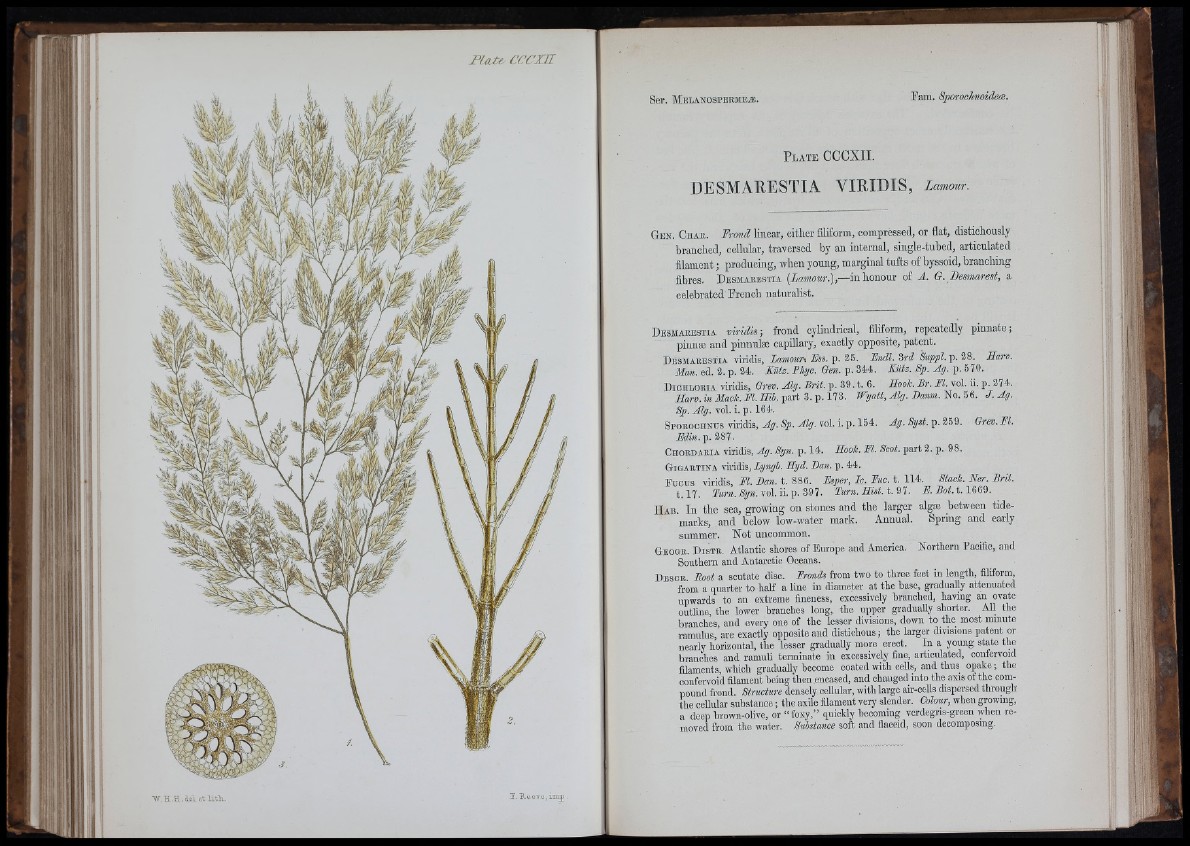
t î
P l a t e CCCXII.
DESMARESTIA VIRIDIS, Lamour,
Gen. Chau. Frond linear, eitlier filiform, compressed, or flat, distioliously
branched, cellular, traversed by an internal, single-tubed, articulated
filament; producing, when young, marginal tufts of byssoid, branching
fibres. D esmarestia (iajBOiii-.),— in honour of A . 0 . JDesmarest, a
celebrated French naturalist.
D esmarestia viridis ; frond cylindrical, filiform, repeatedly pinnate ;
pinnæ and pinnulæ capillary, exactly opposite, patent.
D e s m a r e s t ia v i r i d i s , lamour. Ess. p . 2 5 . Endl. 3rd Suppl. p. 2 8 . Harv.
Man. ed. 2. p. 24. KiiU. Phyc. Gen. p. 344. Kütz. Sp. Ag. p. 570.
D i c i i l o e i a viridis, Grev. Alg. Brit. p. 39. t. 6. Hook. Br. El. vol. ii. p. 274.
Harv. in Mack. El. Hib. part 3. p. 173. TTyatt, Alg. Banm. No. 56. J. Ag.
Sp. Alg. vol. i. p. 164.
S p o r o c h n u s v i r i d i s , Ag. Sp. Alg. vol. i . p. 154. Ag. Syst. p. 259. Grev. El.
Edin. p. 287.
C h o b d a r ia v i r i d i s , Ag. Syn. p . 1 4 . Hook. El. Scot. p a r t 2 . p . 9 8 .
G i g a r t i n a YiriAis,, Lyngh. Hyd. Ban. p. 44.
F u c u s v i r i d i s , M. Ban. t . 8 8 6 . Esper, Ic. Euc. t . 1 1 4 . Stack. Ner. Bril.
1 . 1 7 . y « - « . % » . v o l . i i . p. 3 9 7 . Turn. Hist. t. 91. E. Bot. i . 1339.
H ab I n the sea, growing on stones and the larger algæ between tidemarks,
and below low-water mark. Annual. Spring and early
summer. N o t uncommon.
Geoge. D is t e . Atlantic shores of Europe and America.
Southern and Antarctic Oceans.
Northern Pacific, and
Desc e Root a scutate disc. Eronds from two to three feet in length, filiform,
from a quarter to half a line in diameter at the base, graduaUy attenuated
upwards to an extreme fineness, excessively branched, having an ovate
outline, the lower branches long, the upper graduaUy shorter. All the
branches, and every one of the lesser divisions, down to the most minute
ramulus,’are exactly opposite and distichous ; the larger divisions patent or
nearly horizontal, the lesser graduaUy more erect. In a young state the
branches and ramuU terminate in excessively fine, articulated, confervoid
filaments, which graduaUy become coated with cells, and thus opake ; the
confervoid filament being then encased, and changed into the axis of the compound
frond. Structure densely cellular, with largo air-cells dispersed through
the cellular substance ; the axile filament veiy slender, CoUur, when growing,
a deep brown-olive, or “ foxy,” quickly becoming verdegris-gi-een when removed
from the water. Substance soft and flaccid, soon decomposing.
'V <1
I 'iii